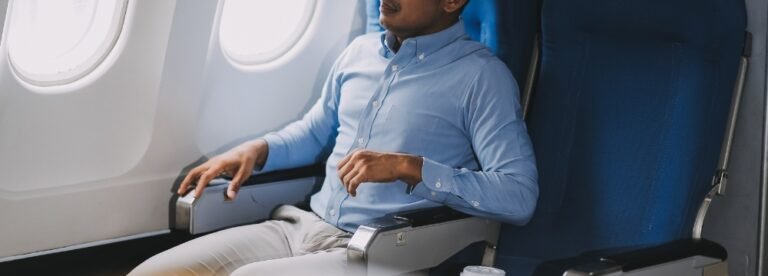As we reach middle age and with airfare as low as it is, air travel is becoming very popular and with the anxiety that comes with urinary frequency and urgency in men with BPH or an enlarged prostate. Indeed, one of the most reported benefits of BPH treatment revolves around patients feeling comfortable taking longer flights because they no longer worry about making it to the bathroom. On the other hand, some men with BPH may even avoid flying altogether.
So what can a man do to ensure his flight goes smoothly and he doesn’t have any accidents trying to get to the bathroom?
Get treatment
This may seem obvious, but many men worry that BPH treatment is a hassle. However, with proper planning, this couldn’t be further from the truth. Today, most BPH treatments are performed in the office or on an outpatient basis and require minimal downtime. However, planning around when you will leave for your trip is crucial. Some procedures such as Rezum steam BPH treatment may take up to six weeks to obtain full benefit, during which time symptoms gradually improve. Improvement of symptoms may be somewhat faster with some surgical options. It’s also important to remember that if PH has been a problem for a while, it takes some time for the bladder to get used to the lack of obstruction. Having a BPH procedure at least a few weeks before a trip will likely make the flight and trip more enjoyable.
Preparing for the flight
If you have been unable to receive treatment or if your BPH medications are no longer working, it is essential to properly prepare for your flight and ensure the least disruption.
Get a seat closer to the bathroom
It’s true that the seats closer to the bathroom can be more expensive and there can be a lot more foot traffic as people get in and out, but it can be worth it, especially on longer flights. Being close to the bathroom helps you get there faster and avoid annoying spills.
Check for turbulence
Fortunately, online resources can show you where the turbulence will be on your flight. Check ahead with a resource like Turbulenceforecast.com and plan your bathroom trips accordingly. The last thing you want to do is get up to go to the bathroom when the seat belt sign is on and you’re in active agitation.
Proactively void
You probably have a pretty good idea of how often you need to go to the bathroom when you’re on the ground, so even if you don’t want to go to the bathroom in the air, take a trip and see if you can void as a precaution. At worst, getting up and walking helps circulation and reduces the risk of deep vein thrombosis.
Hydrate
Hydration is important for a good flight. Hydrating well before your flight helps with circulation and reduces some of the dehydration issues that many travelers experience. Remember that dehydration can also irritate your bladder and cause urinary symptoms. Of course, we don’t want you to hydrate right before your flight, so make sure you’re well-hydrated a few hours before your flight so your body is in tip-top shape, but you reduce the chance of a pee emergency on the plane. Once you reach your destination, re-hydrate as you will probably have lost a lot of fluids on the Journey.
If all else fails, wear a pillow
Luckily, absorbent briefs and pads for adults are more discreet than ever and you can be sure no one thinks twice about them while you’re on the plane. If you really can’t be sure you won’t have an accident, wear a seat cushion to relax. Even with the pad, it is necessary to follow the above recommendations.
The bottom line
While you may be worried about an upcoming flight, you can make it work with good preparation and a conversation with your urologist. Together, you can find the best way to treat or proactively manage your BPH to ensure your flight and trip go as smoothly as possible.
It’s important to remember that most patients don’t realize how simple and safe it is to treat BPH. One of the most common comments we receive after BPH treatment is how patients wish they had done it sooner. It’s never too early to treat lower urinary tract symptoms caused by BPH, so see your urologist. Contact us to learn more and get the relief you need.
